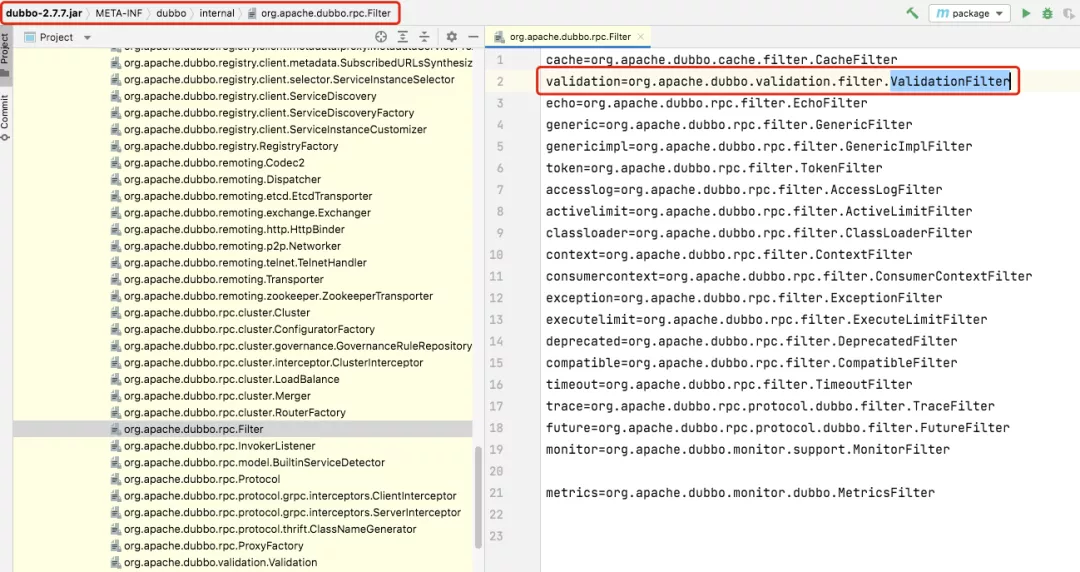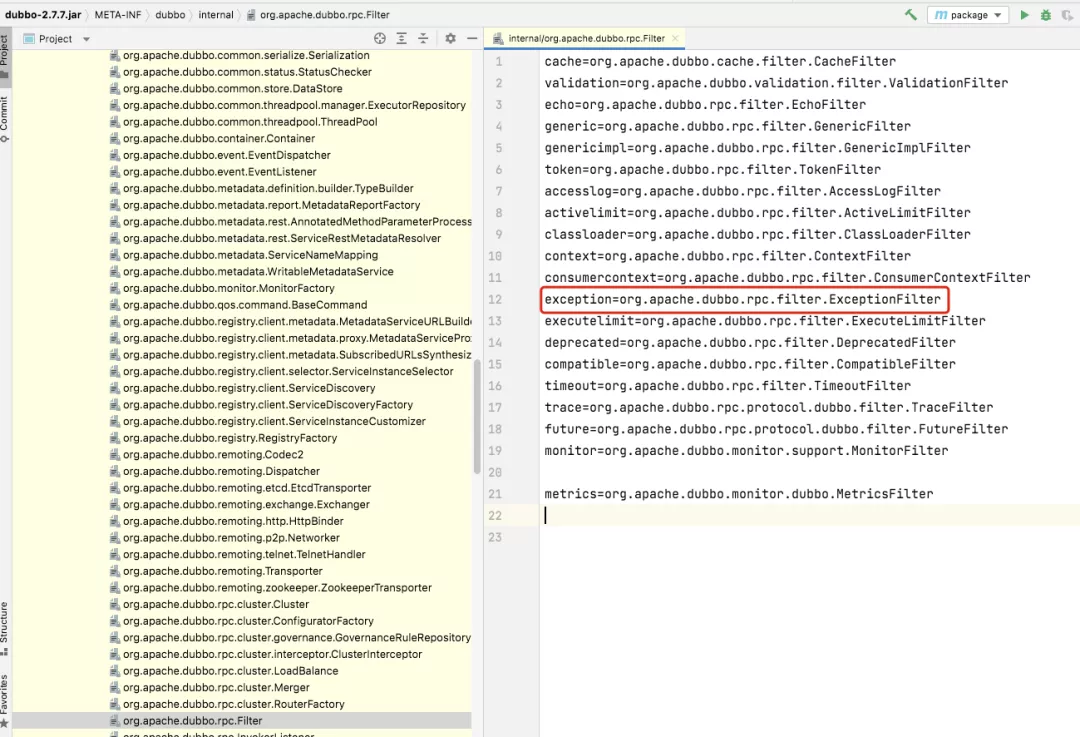Java Dubbo
目前架构是网关直接通过泛化调用Dubbo服务,不同于web Controller使用SpringMVC模块来做到参数注解校验。不过不用担心Dubbo也考虑到了这一点,基于SPI机制提供了ValidationFilter。来看看他是如何实现的。
Dubbo 源码实现
Dubbo SPI定义
什么是Dubbo SPI?简单说是通过文件配置对应class路径后会被执行class里的invoke函数。其中的实现原理大家顺着Dubbo的ExtensionLoader去看下源码就能知道。
ValidationFilter说明
//在哪种服务类型激活//这里的VALIDATION_KEY=“validation” 也就是我们在SPI中需要把key按这个规定定义@Activate(group = {CONSUMER, PROVIDER}, value = VALIDATION_KEY, order = 10000)public class ValidationFilter implements Filter {private Validation validation;public void setValidation(Validation validation) {this.validation = validation;}@Overridepublic Result invoke(Invoker<?> invoker, Invocation invocation) throws RpcException {//如果SPI中定义了validation 那么就进行校验if (validation != null && !invocation.getMethodName().startsWith("$")&& ConfigUtils.isNotEmpty(invoker.getUrl().getMethodParameter(invocation.getMethodName(), VALIDATION_KEY))) {try {//执行参数校验Validator validator = validation.getValidator(invoker.getUrl());if (validator != null) {validator.validate(invocation.getMethodName(), invocation.getParameterTypes(), invocation.getArguments());}} catch (RpcException e) {throw e;} catch (ValidationException e) {//抛出异常 这里的ValidationException需要深挖一下,后面会说// only use exception's message to avoid potential serialization issuereturn AsyncRpcResult.newDefaultAsyncResult(new ValidationException(e.getMessage()), invocation);} catch (Throwable t) {return AsyncRpcResult.newDefaultAsyncResult(t, invocation);}}return invoker.invoke(invocation);}}
基础使用
Maven依赖
SpringBoot项目推荐使用
<dependency><groupId>org.springframework.boot</groupId><artifactId>spring-boot-starter-validation</artifactId></dependency>
手动依赖
<dependency><groupId>javax.el</groupId><artifactId>javax.el-api</artifactId><version>3.0.0</version></dependency><dependency><groupId>org.glassfish</groupId><artifactId>javax.el</artifactId></dependency><dependency><groupId>javax.validation</groupId><artifactId>validation-api</artifactId></dependency><dependency><groupId>org.hibernate</groupId><artifactId>hibernate-validator</artifactId></dependency>
DTO添加validation定义
import lombok.Data;import javax.validation.constraints.NotBlank;import javax.validation.constraints.NotNull;import java.io.Serializable;@Datapublic class PracticeParam implements Serializable {@NotNull(message = "periodId不能为空")private Long periodId;}
服务者interface
public interface IPracticeService {boolean practiceAdd(PracticeParam practiceParam);}
Dubbo RPC单元测试
@SpringBootTest(classes = ClientApplication.class)@RunWith(SpringRunner.class)@Slf4jpublic class PrecticeTest {@DubboReference(group = "user")private IPracticeService practiceLogicService;@Testpublic void add(){PracticeParam practiceParam=new PracticeParam();log.info(String.valueOf(practiceLogicService.practiceAdd(practiceParam)));}}
测试结果
javax.validation.ValidationException: Failed to validate service: com.xx.contract.IPracticeService, method: practiceAdd, cause: [ConstraintViolationImpl{interpolatedMessage='periodId不能为空', propertyPath=periodId, rootBeanClass=class com.xx.request.PracticeParam, messageTemplate='periodId不能为空'}]
看结果是生效了,不过这和实际项目中还有些距离。不能把这个异常抛给网关,根据项目需要适配上全局异常试试。
源码分析与扩展
Dubbo异常处理
ExceotionFilter源码分析
//在服务提供者端生效@Activate(group = CommonConstants.PROVIDER)public class ExceptionFilter implements Filter, Filter.Listener {private Logger logger = LoggerFactory.getLogger(ExceptionFilter.class);@Overridepublic Result invoke(Invoker<?> invoker, Invocation invocation) throws RpcException {return invoker.invoke(invocation);}@Overridepublic void onResponse(Result appResponse, Invoker<?> invoker, Invocation invocation) {//异常处理逻辑if (appResponse.hasException() && GenericService.class != invoker.getInterface()) {try {Throwable exception = appResponse.getException();// directly throw if it's checked exceptionif (!(exception instanceof RuntimeException) && (exception instanceof Exception)) {return;}// directly throw if the exception appears in the signaturetry {Method method = invoker.getInterface().getMethod(invocation.getMethodName(), invocation.getParameterTypes());Class<?>[] exceptionClassses = method.getExceptionTypes();for (Class<?> exceptionClass : exceptionClassses) {if (exception.getClass().equals(exceptionClass)) {return;}}} catch (NoSuchMethodException e) {return;}// for the exception not found in method's signature, print ERROR message in server's log.logger.error("Got unchecked and undeclared exception which called by " + RpcContext.getContext().getRemoteHost() + ". service: " + invoker.getInterface().getName() + ", method: " + invocation.getMethodName() + ", exception: " + exception.getClass().getName() + ": " + exception.getMessage(), exception);// directly throw if exception class and interface class are in the same jar file.String serviceFile = ReflectUtils.getCodeBase(invoker.getInterface());String exceptionFile = ReflectUtils.getCodeBase(exception.getClass());if (serviceFile == null || exceptionFile == null || serviceFile.equals(exceptionFile)) {return;}// directly throw if it's JDK exceptionString className = exception.getClass().getName();if (className.startsWith("java.") || className.startsWith("javax.")) {return;}// directly throw if it's dubbo exceptionif (exception instanceof RpcException) {return;}// otherwise, wrap with RuntimeException and throw back to the client//重点时这句,替换异常信息appResponse.setException(new RuntimeException(StringUtils.toString(exception)));} catch (Throwable e) {logger.warn("Fail to ExceptionFilter when called by " + RpcContext.getContext().getRemoteHost() + ". service: " + invoker.getInterface().getName() + ", method: " + invocation.getMethodName() + ", exception: " + e.getClass().getName() + ": " + e.getMessage(), e);}}}@Overridepublic void onError(Throwable e, Invoker<?> invoker, Invocation invocation) {logger.error("Got unchecked and undeclared exception which called by " + RpcContext.getContext().getRemoteHost() + ". service: " + invoker.getInterface().getName() + ", method: " + invocation.getMethodName() + ", exception: " + e.getClass().getName() + ": " + e.getMessage(), e);}// For test purposepublic void setLogger(Logger logger) {this.logger = logger;}}
基础使用
定义SPI
项目结构说明:
文件定义(Dubbo SPI需要严格按如下路径和文件名)
src/main/resources/META-INF/dubbo/org.apache.dubbo.rpc.Filter
文件内容
validation=com.xx.xx.config.DubboValidationFilterexception=com.xx.xx.config.DubboExceptionFilter
自定义DubboValidationFilter
import com.xx.exception.ParamException;import org.apache.dubbo.common.extension.Activate;import org.apache.dubbo.common.utils.ConfigUtils;import org.apache.dubbo.rpc.*;import org.apache.dubbo.validation.Validation;import org.apache.dubbo.validation.Validator;import javax.validation.ConstraintViolation;import javax.validation.ConstraintViolationException;import java.util.Set;import static org.apache.dubbo.common.constants.CommonConstants.PROVIDER;import static org.apache.dubbo.common.constants.FilterConstants.VALIDATION_KEY;@Activate(group = {PROVIDER}, value = VALIDATION_KEY, order = -1)public class DubboValidationFilter implements Filter {private Validation validation;public void setValidation(Validation validation) {this.validation = validation;}@Overridepublic Result invoke(Invoker<?> invoker, Invocation invocation) throws RpcException {if (validation != null && !invocation.getMethodName().startsWith("$")&& ConfigUtils.isNotEmpty(invoker.getUrl().getMethodParameter(invocation.getMethodName(), VALIDATION_KEY))) {try {Validator validator = validation.getValidator(invoker.getUrl());if (validator != null) {//挖掘点 validate函数的源码validator.validate(invocation.getMethodName(), invocation.getParameterTypes(), invocation.getArguments());}}//Dubbo源码里捕获的是ValidationException这个异常,原始信息变成了字符串,所以接下来//通过JValidator源码分析进行如下扩展catch (ConstraintViolationException e) {//获取我们的异常,这里的异常时集合的,因为我们参数可能多个都不通过StringBuilder message = new StringBuilder();Set<ConstraintViolation<?>> violations = e.getConstraintViolations();for (ConstraintViolation<?> violation : violations) {//这里只获取第一个不通过的原因message.append(violation.getMessage().concat(";"));break;}//项目自定义异常类型,网关可以捕获到该异常throw new ParamException(message.toString());} catch (RpcException e) {throw e;} catch (Throwable t) {return AsyncRpcResult.newDefaultAsyncResult(t, invocation);}}return invoker.invoke(invocation);}}
JValidator源码分析
//Validated 校验过程public void validate(String methodName, Class<?>[] parameterTypes, Object[] arguments) throws Exception {List<Class<?>> groups = new ArrayList<>();Class<?> methodClass = methodClass(methodName);if (methodClass != null) {groups.add(methodClass);}//异常返回信息 violationsSet<ConstraintViolation<?>> violations = new HashSet<>();Method method = clazz.getMethod(methodName, parameterTypes);Class<?>[] methodClasses;if (method.isAnnotationPresent(MethodValidated.class)){methodClasses = method.getAnnotation(MethodValidated.class).value();groups.addAll(Arrays.asList(methodClasses));}// add into default groupgroups.add(0, Default.class);groups.add(1, clazz);// convert list to arrayClass<?>[] classgroups = groups.toArray(new Class[groups.size()]);Object parameterBean = getMethodParameterBean(clazz, method, arguments);if (parameterBean != null) {violations.addAll(validator.validate(parameterBean, classgroups ));}for (Object arg : arguments) {validate(violations, arg, classgroups);}if (!violations.isEmpty()) {logger.error("Failed to validate service: " + clazz.getName() + ", method: " + methodName + ", cause: " + violations);//这里原始异常是它,所以我们需要捕获它,得到violationsthrow new ConstraintViolationException("Failed to validate service: " + clazz.getName() + ", method: " + methodName + ", cause: " + violations, violations);}}
自定义DubboExceptionFilter
@Slf4j@Activate(group = CommonConstants.PROVIDER)public class DubboExceptionFilter extends ExceptionFilter {@Overridepublic Result invoke(Invoker<?> invoker, Invocation invocation) throws RpcException {return invoker.invoke(invocation);}@Overridepublic void onResponse(Result appResponse, Invoker<?> invoker, Invocation invocation) {log.error("dubbo global exception ---------->{}", appResponse.getException());if (appResponse.hasException() && GenericService.class != invoker.getInterface()) {try {Throwable exception = appResponse.getException();// 自定义异常处理if (exception instanceof ParamException) {//按项目log收集规范输出log.error("dubbo service exception ---------->{}", exception);return;}......} catch (Throwable e) {log.warn("Fail to ExceptionFilter when called by " + RpcContext.getContext().getRemoteHost() + ". service: " + invoker.getInterface().getName() + ", method: " + invocation.getMethodName() + ", exception: " + e.getClass().getName() + ": " + e.getMessage(), e);}}}}
PRC单元测试
org.apache.dubbo.remoting.RemotingException: com.xx.exception.ParamException: periodId不能为空;com.xx.exception.ParamException: periodId不能为空;
高级进阶
在业务里一个DTO对象会用于新增或更新,在新增时不需要主键ID,在更新时需要主键ID。
就需要引入分组的概念了。
定义validation groups,在API模块中定义两个分组。
//用于新增public interface InsertValidation {}//用于更新public interface UpdateValidation {}
定义 DTO
@Datapublic class PracticeParam implements Serializable {//只用于更新@NotNull(groups={UpdateValidation.class},message = "id不能为空")private Integer id;// 如果两组校验都需要可以省去group的定义,完整的如下// @NotBlank(groups={InsertValidation.class, UpdateValidation.class},message = "名称不能为空")@NotNull(message = "periodId不能为空")private Long periodId;}
服务提供者interface
public interface IPracticeService {//因为periodId参数是默认不区分组的,所以这里省去了Validated注解boolean practiceAdd(PracticeParam practiceParam);boolean practiceEdit(@Validated(value = {UpdateValidation.class}) PracticeParam practiceParam);}
生产环境验证



